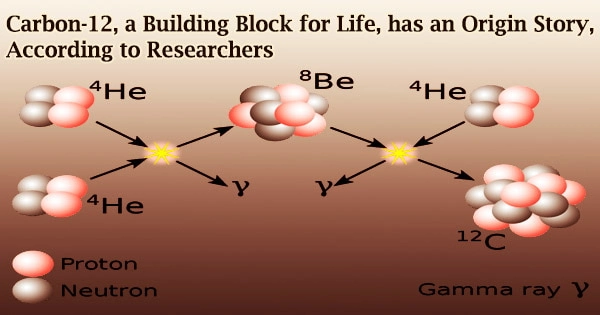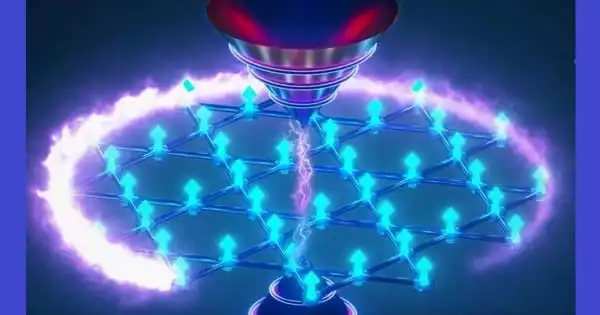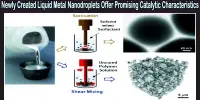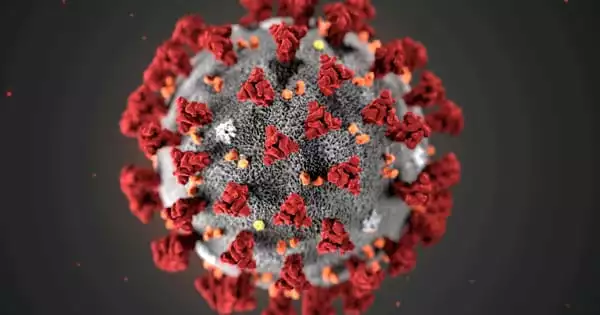A multinational team of researchers has theorized how harsh conditions in stars make carbon-12, which they describe as “a vital doorway to the beginning of life,” with the help of the world’s most powerful supercomputer and new artificial intelligence approaches.
“How does the cosmos manufacture carbon-12?” questioned James Vary, a professor of physics and astronomy at Iowa State University who has been a longtime member of the study group.
“It turns out it’s not easy to produce carbon-12,” Vary said.
Carbon-12 (12C) is the most abundant of the two stable isotopes of carbon (the other being carbon-13), accounting for 98.93 percent of element carbon on Earth; its abundance is owing to the triple-alpha process, which creates it in stars. Carbon is a result of fusion, a cosmic nuclear process in which helium nuclei are “burned” and fused together to generate carbon atoms with the atomic number of 12.
Emergent, unstable, excited-state carbon nuclei with three loosely coupled clumps, each with two protons and two neutrons, require enormous heat and pressures within stars or in stellar collisions and explosions. A small percentage of those unstable carbon nuclei can emit extra energy in the form of gamma rays, resulting in stable carbon-12, the material of life.
The researchers’ supercomputer simulations and resulting theory for the nuclear structure of carbon that favors its production in the cosmos were recently published in the online journal Nature Communications.
Takaharu Otsuka of the University of Tokyo, the RIKEN Nishina Center for Accelerator-Based Science, and the Japan Atomic Energy Agency’s Advanced Science Research Center is the corresponding author.
The research explains how helium-4 atoms with two protons and two neutrons can cluster to generate considerably heavier atoms, including the Hoyle state, an unstable, excited carbon-12 state (predicted by theoretical astrophysicist Fred Hoyle in 1953 as a precursor to life as we know it).
There’s a lot of subtlety and a lot of beautiful interactions going on in there. This nucleosynthesis in extreme environments produces a lot of stuff; including carbon.
Professor James Vary
This alpha-particle clustering, according to the researchers, “is a very attractive and exciting hypothesis that is indeed possible because the (alpha) particle is exceptionally stable with a significant binding energy.”
One of the most important biological processes is photosynthesis, which involves the chemical conversion of carbon dioxide to carbohydrates in green plants. Cascaded chemical exchange reactions using amine carbamate can separate carbon isotopes in the form of carbon dioxide gas.
The researchers used supercomputer simulations, including calculations on the Fugaku supercomputer at the RIKEN Center for Computational Science in Kobe, Japan, to test their theory. According to the latest TOP500 supercomputer rankings, Fugaku is the world’s most powerful supercomputer, three times more powerful than No. 2.
The researchers also worked ab initio, or from the beginning, according to Vary, which means their calculations were based on existing science and didn’t incorporate any additional assumptions or factors.
They also created statistical learning approaches to show alpha clustering in the Hoyle state and the eventual creation of stable carbon-12, which is a branch of computational artificial intelligence.
Vary said the team has spent more than a decade developing software, refining supercomputer codes, doing computations, and resolving lesser issues in preparation for the current project.
“There’s a lot of subtlety a lot of beautiful interactions going on in there,” Vary said.
The researchers wrote that all of the calculations, physical numbers, and theoretical subtleties match the experimental results in this area of nuclear physics.
As a result, they believe they have some basic answers about carbon-12’s origins. More research looking for “fine-grain detail” about the mechanism and how it works, according to Vary, should follow.
Was the majority of carbon synthesis, for example, due to internal processes in stars? Vary was the one who inquired. Was it supernova starbursts, or something else? Or super-dense neutron star collisions?
One thing is now clear to the researchers: “This nucleosynthesis in extreme environments produces a lot of stuff,” Vary said, “including carbon.”
















